Hi! I’m YUKORIN. I am a wheelchair user. On June 17, Accessible members and I went to the Edo-Tokyo Museum and the Japanese Sword Museum as a part of our wheelchair accessibility reviews.
We met at the West Gate of JR Ryogoku Station. Firstly we set off for the Edo-Tokyo Museum. It was a cloudy day in an interval of the rainy season. It was a perfect day for going out as it was neither too hot nor too cold.

A sign of the Edo-Tokyo Museum

On the way to the museum
The Edo-Tokyo Museum
We arrived at the Edo-Tokyo Museum within about a 5-minute walk from JR Ryogoku Station. What a huge building! There is a main entrance behind the stairs.

The Edo-Tokyo Museum
Here is the main entrance. It is flat as you can see. The inside of the building will also be large.
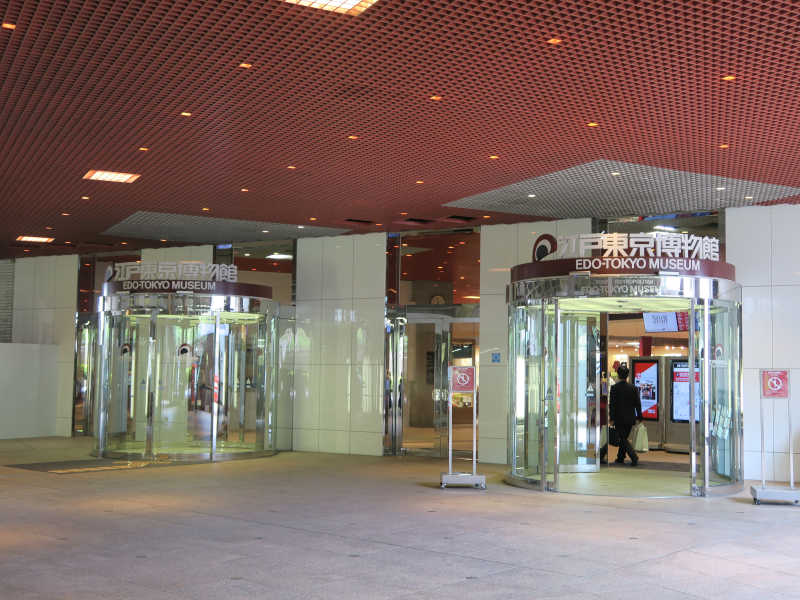
The main entrance of the Edo-Tokyo Museum
We admired the permanent exhibition where we can get insights into how people had lived their lives from the Edo period to modern Tokyo. The admission fee for the permanent exhibition is 600 yen for general visitors. People with disabilities together with two attendants can be admitted for free if they show their disability certificate to a staff member at the ticket counter on the 1st floor. I was a bit surprised that two attendants are allowed to enter the exhibition for free although it is common for one attendant to be admitted to an exhibition for free.

The ticket counter and Information
Wheelchairs and baby buggies can be rented inside the museum without charge.

Rental wheelchairs

Rental baby buggies
Here we go! Take the elevator up to the 6th floor where we enjoy the permanent exhibition. Below is the spacious elevator hall. Each of the elevators is big too.
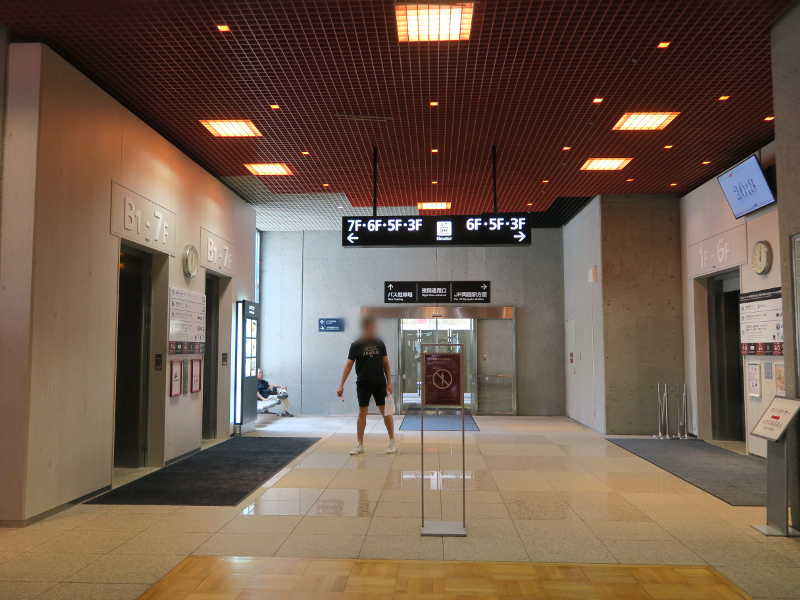
The elevator hall on the 1st floor
The permanent exhibition is held on the 5th floor and the 6th floor. Visitors watch it first by going up to the 6th floor and second by going down to the 5th floor. General visitors take an escalator down to the 5th floor. On the other hand, there is an elevator for wheelchair users and baby buggies to go down to the 5th floor. You need to ask a staff member to usher you to the elevator when you would like to use it. A staff member told us about it at the entrance counter of the exhibition on the 6th floor. Wheelchairs users will be relieved to be informed on a wheelchair accessible route from the beginning.

We were told about the elevator for wheelchair users.
Free guide tours are provided by volunteers. You can make an advance reservation by phone and also ask for the guide tour on the day. We requested the guide tour at the volunteer guide reception counter without a reservation. They are offered in Japanese, English, Chinese, Korean, French, German, Spanish and Italian. However, some of these languages are not available on certain days. The guide tour takes about an hour and a half to two hours. You will be able to spend more than half a day just admiring the permanent exhibition.

The volunteer guide reception counter
Audio guides and pamphlets are also available in multi-languages. Visitors from overseas can enjoy the exhibition too.

Audio guides
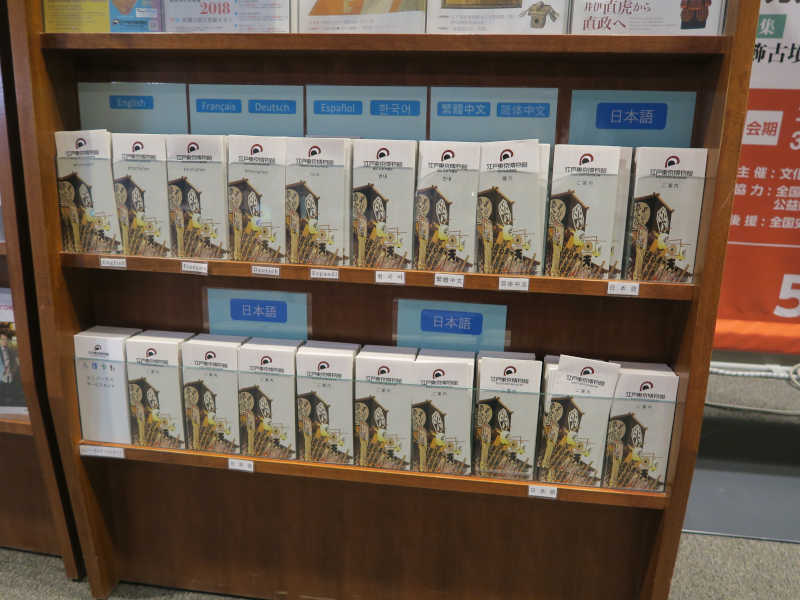
Pamphlets
We are going to walk across the full-sized replica of the Nihonbashi Bridge. The Edo Zone awaits us at the other side of the bridge. I get excited!

The replica of the Nihonbashi Bridge
Our volunteer guide told us in detail about the culture, history and lives among common people and aristocrats during the Edo period while we appreciated various miniature models and full-sized replicas. I learned a lot from him.

A replica of painted Fusuma (Japanese sliding doors)

A Nishiki-e (woodblock prints) shop

A miniature model of a Mitsukoshi department store in the early days

A sushi stand
However, I found a problem. I could not take a look at the inside of the miniature model of a warrior residence from the height of my wheelchair.
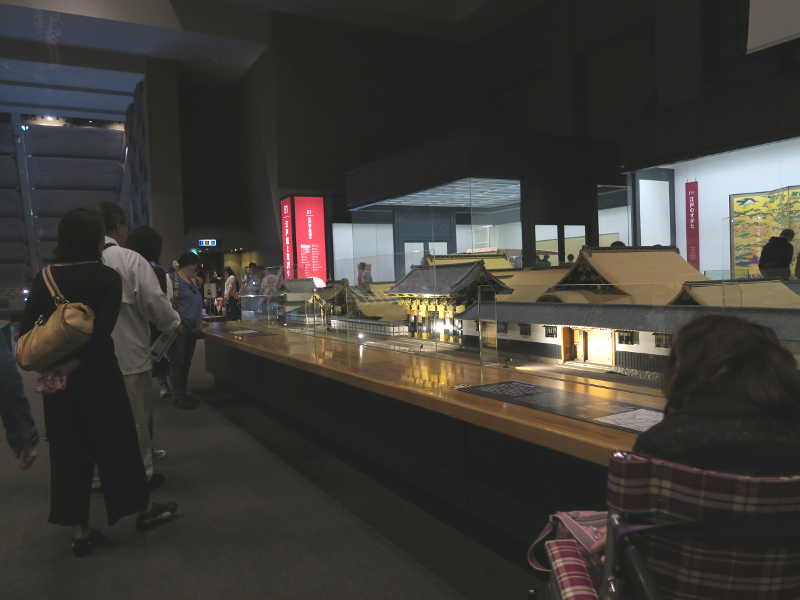
The miniature model is placed too high for me.
I could only see the outside of the warrior residence. I wonder how people who can stand could look down inside as you can see in the right photo below.
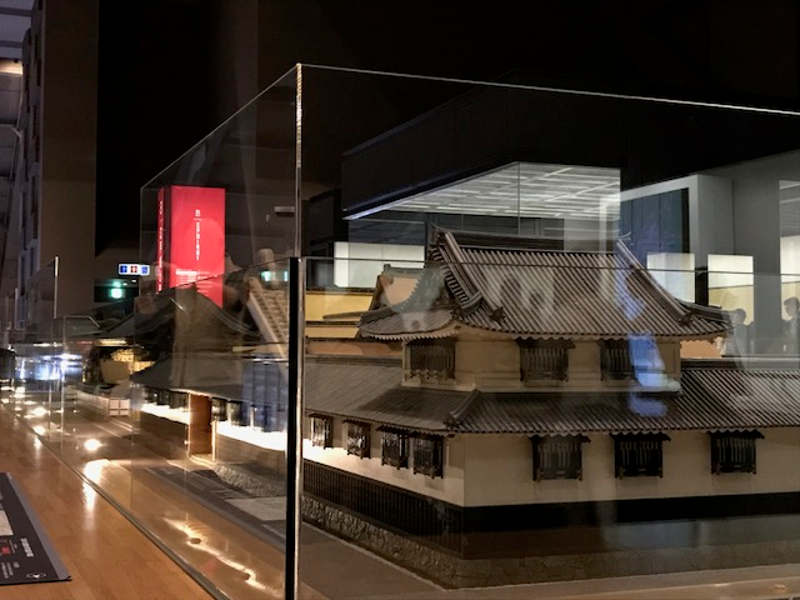
The warrior residence wheelchair users can see

The inside of the warrior residence which standing people can look down
Below is the elevator for wheelchair users. A security guard ushered us into it.

The elevator for wheelchair users
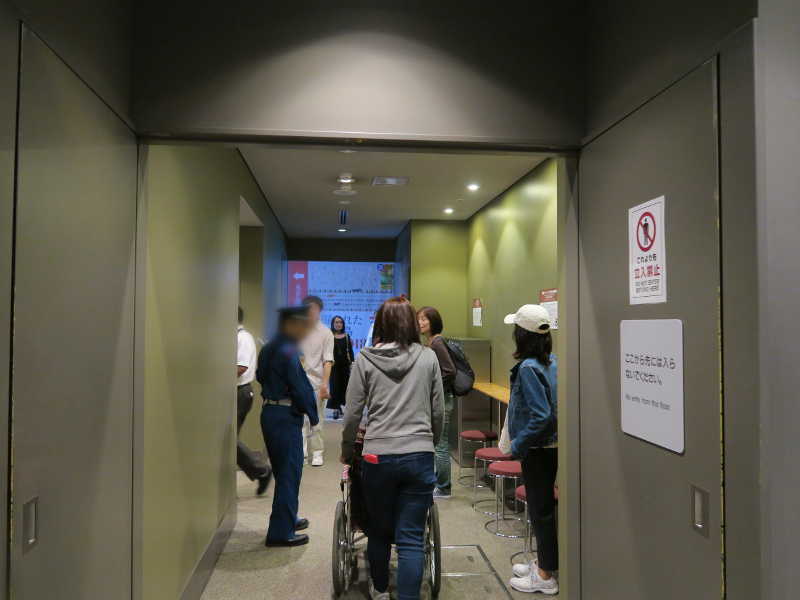
We went down to the 5th floor by a security guard’s guide.
It took an hour and a half to walk about only the Edo Zone. We gave up viewing the Tokyo Zone because we had to visit the Japanese Sword Museum later. The last full-sized replica we saw was a Kabuki stage before we headed for the exit. I was impressed with the realistic stage and figures of Kabuki actors which were just replicas. I look forward to watching the Tokyo Zone too if I can have a chance to visit the museum again.

The Kabuki stage
I used one of the multipurpose restrooms when we went down to the 1st floor. This restroom is well-equipped. But I found it a little challenging to wash my hands over the small sink. Also, the mirror was installed so high that I could not see my reflection in the mirror from my wheelchair.
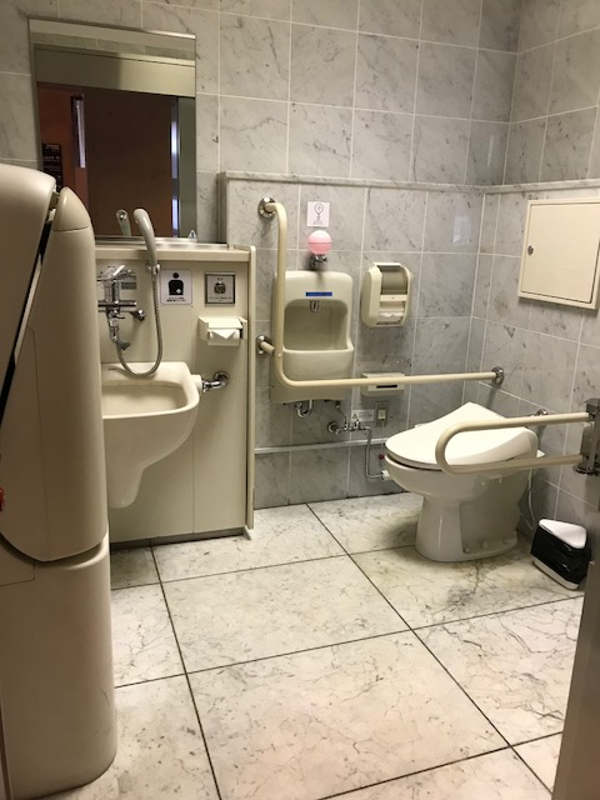
The multipurpose restroom on the 1st floor
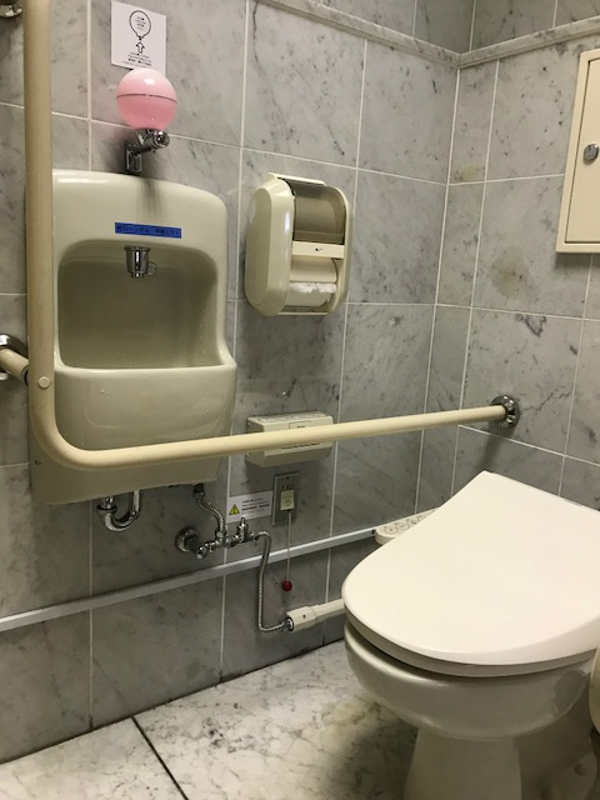
The small sink
The Japanese Sword Museum
The second place where we carried out our wheelchair accessibility check was the Japanese Sword Museum. As the name indicates, Japanese swords are exhibited at the museum. It is located about a 5-10 minute walk from the Edo-Tokyo Museum and is next to the Kyu-Yasuda Garden which is a Japanese garden.
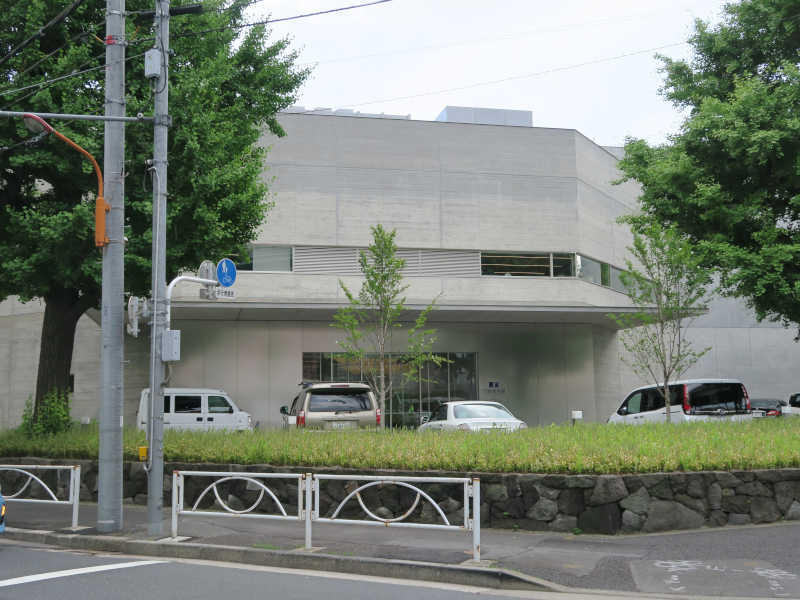
The Japanese Sword Museum
This building has recently been constructed where wheelchair accessibility is taken into account. The inside of the museum is spacious. There are an elevator and multipurpose restroom. The admission fee is 1,000 yen for general visitors. When people with disabilities present their certificate at the ticket counter, they and one attendant per disabled person are admitted to the exhibition for free.
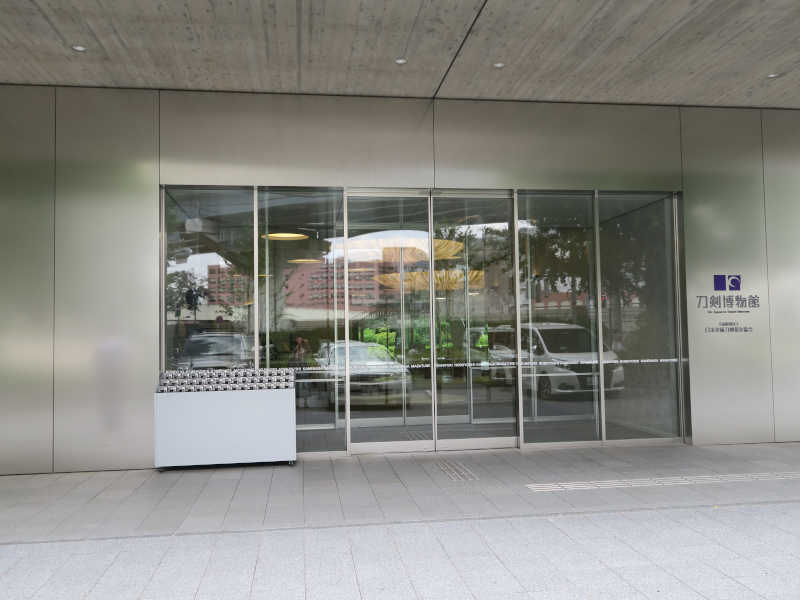
The entrance of the museum

Exhibits at the lobby
A multipurpose restroom with a simple design. It has enough space and equipment for a wheelchair user. I found it satisfactory as a wheelchair accessible restroom although the mirror was installed a bit high for me.
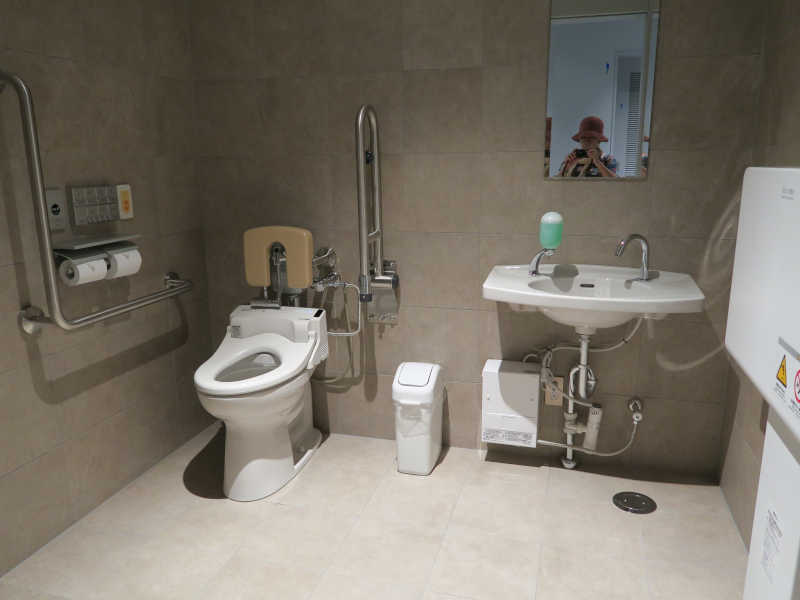
The multipurpose restroom on the 2nd floor
We felt sorry that photography was not allowed in the exhibition room. Glittering Japanese swords on stuff like cushions were displayed inside exhibition cases as if they were jewels. However, most of the exhibition cases were placed in the high positions and information panels were fixed on the bottom of the cases. Therefore, I could look up and see the swords while I could not read what was written on the panels at all from the height of my wheelchair. That is why I was only able to see visual things such as the difference of the lengths and the temper patterns of those swords because I am not familiar with Japanese swords. I could have read the information if the panels had been displayed in vertical positions.

A sign saying “No photographs.”
We went out to the roof garden of the museum. Visitors can look down the Kyu-Yasuda Garden from the roof garden. But the wall of the balcony was too high for me to watch the view of the garden. This wall might not be able to be rebuilt to make it lower for some security reasons. However, I wish a small window as an example would have been made in the wall for wheelchair users to enjoy the scenery.

The high wall blocked my view of the garden.
The Kyu-Yasuda Garden
We dropped in at the Kyu-Yasuda Garden on our way home. The path inside the garden is covered with gravel. Although I thought it would be hard for a wheelchair user to enter, unexpectedly I could go in and walk towards stairs in the garden.

The entrance of the Kyu-Yasuda Garden

I was able to walk on the gravel path.
When gravel is firmly fixed on the ground, wheelchair users can walk even on the gravel road as wheelchair tires don’t get buried in the gravel.

The gravel path fixed on the ground
The Japanese garden was full of green plants sprouted in the beginning of summer. This beautiful scenery purified my mind. I was really happy to go there.

The scenery of Kyu-Yasuda Garden

We took the commemorative photo in front of the entrance of the Japanese Sword Museum.
When we look back upon history, it is said that we should not see things from our present perspective. At the Edo-Tokyo Museum we were able to explore the wonderful Edo culture and life filled with people’s wisdom as the tour guide and replicas made it easier to get their perspective in the Edo period. At the Japanese Sword Museum I could not help seeing Japanese swords as scary stuff. From a different point of view, however, swords might be an important weapon for samurai warriors to protect themselves, symbol for their pride and their fashion as well. I was able to look back on Japanese history and culture through this wheelchair accessibility review. Both museums are wheelchair friendly if you let go of some detailed points. I keenly recommend wheelchair users and tourists from overseas to visit the Edo-Tokyo Museum and the Japanese Sword Museum if you would like to learn about Japanese history and culture. You may discover something for yourself.
